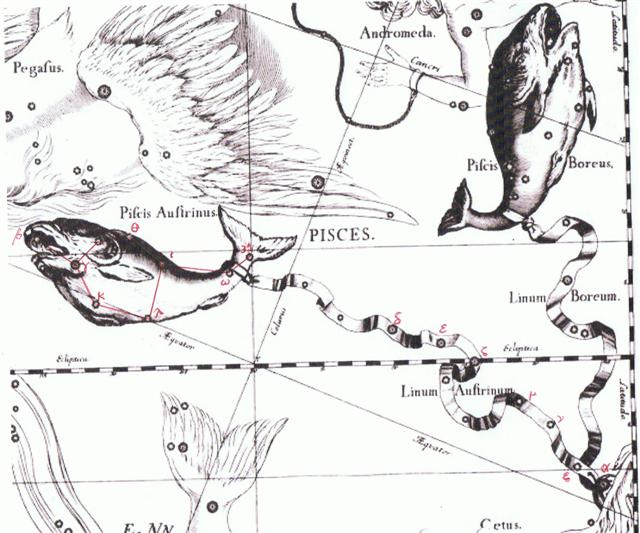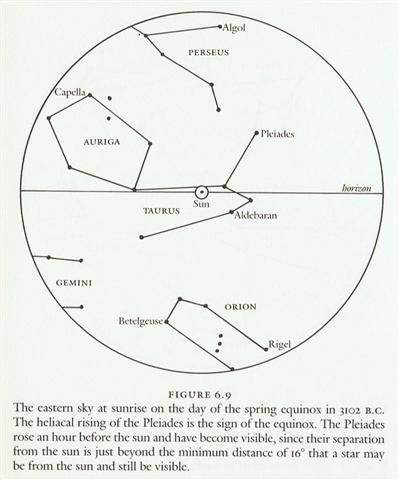In the era of Pisces there is logic in beginning to count anew at the mouth of the first of the Fishes. There is half a month from the mouth (fum) of the fish to its belly (batn):
However, according to Hevelius 32 Piscium is not at its belly but at its tail (one day after Dzaneb, 'the Tail', ω):
But Ibn 'Arab could have had a longer fish. Although the star Fum Al Samakah did not rule any of the manzils of Ibn 'Arab it was evidently anyhow important. And his method to begin counting anew for each constellation meant he avoided the problem of precession. His star map would have been unperturbed by how Sun began a little earlier for each year. Dubhe (α Ursae Majoris) is at the other side of the sky compared to Fum al Samakah (and to Fomalhaut):
Day 350 may have been important also for the creator of the C text. The day after the heliacal rising of Simmah and φ Aquarii has a hakaariki (making a Ruler) glyph. There are 4 days from 23h to Saad Balaa 13 (= March 10, Gregorian day 70), i.e. to RA day 350 + 4 = 354 (= 12 * 29½):
There could have been a transition period of 15 days, from 23h (March 6) to March 21. Maybe we should compare it with the period of 15 days from the Mouth of the Fish to 32 Piscium. From day 350 to day 365 there are 15 days. In rongorongo times the first of the fishes was ending just before the March equinox and there were bands connecting the first and the second fishes with a knot (Alrisha) 29 days later:
When Thuban (α Draconis) was close to the full Moon it meant Sun had reached the knot at the end of their strings. Thus playing with strings ought to be forbidden beyond April 19. In Cb1-3 hau tea with Janus eyes was at a point where the 'Sea' may have ended and beyond this point the idea of the Gemini Twins could have hovered. The manzil Al Muakhar was ruled by Pollux and in India the first nakshatra station was Punarvasu: ... In Hindu legend there was a mother goddess called Aditi, who had seven offspring. She is called 'Mother of the Gods'. Aditi, whose name means 'free, unbounded, infinity' was assigned in the ancient lists of constellations as the regent of the asterism Punarvasu. Punarvasu is dual in form and means 'The Doublegood Pair'. The singular form of this noun is used to refer to the star Pollux. It is not difficult to surmise that the other member of the Doublegood Pair was Castor. Then the constellation Punarvasu is quite equivalent to our Gemini, the Twins. In far antiquity (5800 B.C.) the spring equinoctial point was predicted by the heliacal rising of the Twins ... Punarvasu is one of the twenty-seven (or twenty-eight) zodiacal constellations in the Indian system of Nakshatras. In each of the Nakshatras there is a 'yoga', a key star that marks a station taken by the moon in its monthly (twenty-seven- or twenty-eight-day course) through the stars ... In ancient times the priest-astronomers (Brahmans) determined the recurrence of the solstices and equinoxes by the use of the gnomon. Later they developed the Nakshatra system of star reference to determine the recurrence of the seasons, much as the Greeks used the heliacal rising of some star for the same purpose. An example of the operation of the Nakshatra system in antiquity can be seen in figure 6.9:
Here we see that the spring equinox occurred when the sun was at its closest approach to the star Aldebaran (called Rohini by the Hindus) in our constellation Taurus. But, of course, the phenomenon would not have been visible because the star is too close to the sun for observation. The astronomers would have known, however, that the equinoctial point was at Aldebaran by observing the full moon falling near the expected date or near a point in the sky exactly opposite Aldebaran (since the full moon is 180º from the sun), that is, near the star Antares ... The system of Nakshatras, then, is quite distinct from systems that use the appearance of heliacally rising or setting stars as the equinoctial marker. Furthermore, the Indian system is all but unique in that two calendar systems competed with each other - a civil system, in which the year's beginning was at the winter solstice, and a sacrificial year, which begins at the spring equinox. The beginning of the former was determined by the Nakshatra method, observing the winter full moon's apparition near the point of the summer solstice in the sky ... The arrival of the beginning of the sacrificial year might be determined by the Nakshatra method - observation of the spring full moon near to the autumn Nakshatra in Virgo. More commonly, however, it was determined as in the Greek system, by direct observation of the heliacal rising of a sign star. In the current calendar, for example - one unchanged since the fifth century A.D. - the yoga star of the Nakshatra Ashvini (beta Arietis) ushers in the spring equinox at its heliacal rising ... Heliacal Sheratan (β Arietis) was probably connected with the great raaraa ('no Sun as yet') glyph in Cb1-1 and the great hau tea 2 nights later with both heliacal Alrisha and nakshatra Thuban (at 14h). The memory of Pollux at spring equinox was kept intact in the Hindu system and also by e.g. the connection between heliacal Sham (the Arrow, α Sagittae) and nakshatra Pollux:
My reconstruction of the 22nd manzil of Ibn 'Arab has 'The Fortune of the Slayers' beginning with January 13, the Gregorian day number of which equals the synodic cycle of Saturn. Dabih, β Capricorni, at the head of the old goat, rose heliacally 10 days later, when presumably the winter straw goat' was 'slaughtered' by the arrows (rays) of the returning Sun, turning him to 'ashes' (kihikihi). Therefore the yoke ('uniting star') had to be another star and nakshatra Pollux was an obvious choice. The 22nd manzil of Ibn 'Arab will end where his 23rd manzil is beginning and according to my reconstruction the date Al Sa’d al Dhabih 13 could be day 299 from the beginning of his calendar. 299 = 23 * 13. | ||||||||||||||||||||||||||||||||||||||||||||||||||||||||||||||||||||||||||||||||||||||||||||||||||||||||||||||||||||||||||||||||||||||||||||||||||||||||||||||||||||||||||||||||||||||||||||||||||||||||||||||||||||||||||||||||||||||||||||||||||||||||||||||||||||||||||||||||||||||||||||||||||||||||||||||||||||||||||||||||||||||||||||||||||||||||||||||||||||||||||||||||||||||


















